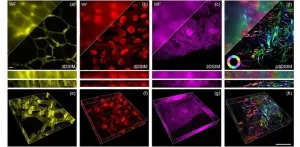(Press-News.org) Feminist health narratives are being co-opted by commercial interests to market new technologies, tests, and treatments that are not backed by evidence, argue researchers in The BMJ today.
Dr Tessa Copp at The University of Sydney and colleagues say such marketing behaviour risks harming women through inappropriate medicalisation, overdiagnosis, and overtreatment.
They call for greater wariness of simplistic health messages that any knowledge is power, and urge health professionals and governments to ensure that easily understood, balanced information is available based on high quality scientific evidence.
Corporations have historically exploited health agendas by co-opting messaging about female autonomy to encourage women’s consumption of unhealthy commodities such as tobacco and alcohol, they explain. But this phenomenon has now expanded across women’s health.
The problem, they say, is not with the use of health technologies, tests, and treatments per se, but in the way commercial marketing and advocacy efforts push such interventions to a much larger group of women than is likely to benefit without being explicit about their limitations.
They discuss two current examples to argue how feminist discourse is being co-opted to promote non-evidence-based healthcare to healthy women.
The first is the anti-müllerian hormone (AMH) test, which measures levels of AMH in the blood, linked to the number of eggs in a woman’s ovaries.
Despite clear evidence that the test cannot reliably predict a woman’s chances of conceiving, fertility clinics and online companies market and sell the test to the general public, using phrases such as “Information is power and lets you take charge of your fertility.”
Dr Copp and colleagues argue that misleading marketing using feminist rhetoric that encourages women with no signs or symptoms of infertility to seek AMH testing to check their fertility or to inform their reproductive planning “ultimately undermines empowerment and informed decision making as the evidence to date shows the test is invalid for these purposes.”
The second is the view that all women having screening should be notified about their breast density, one of several independent risk factors for breast cancer.
Arguments emphasise women’s “right to know” but the authors note that breast density notification is currently being used to promote additional screening without robust evidence (and without mentioning the lack of evidence) that it prevents breast cancer deaths.
Breast density notification can also increase women’s anxiety, confusion, and intentions to seek additional screening, while the unreliability of breast density measurement is another concern, they add.
Some have argued that technological advances, more information, and increasingly individualised care can still advance women’s knowledge and health even when there is no clear evidence that the benefits outweigh the harms.
However, while the authors fully support stronger patient autonomy, they suggest that marketing and campaigning for interventions and provision of information without stating the limitations or unclear evidence of benefit “risk causing more harm than good and therefore may go against the empowerment being sought.”
In conclusion, they say “we need to ensure the goals of feminist health advocacy are not undermined through commercially driven use of feminist discourse pushing non-evidence based care.”
In a linked editorial, Sarah Hawkes at University College London argues that in an era when powerful commercial companies resist regulation “we should draw on the power of collective action” to tackle the activities of commercial organisations.
From the success of the Nepal Women’s Organisation in bringing stakeholders together to catalyse legal access to abortion, to social movements tackling obstetric violence and promoting more respectful and evidence based maternal care in Brazil, women’s movements “have challenged unequal power structures and improved health outcomes,” she writes.
She notes that success for these movements came not from women’s groups acting alone but from advocacy coalitions involving multiple groups united around a common goal.
As such, she says this model “can be both successful and replicable as a strategy for protecting and improving all aspects of women’s health, promoting women’s health rights as an issue of social justice rather than corporate profits.”
[Ends]
END
Companies are adopting feminist narratives to influence women’s health
Women’s health cannot be allowed to be hijacked by vested interests, say experts
2024-02-15
ELSE PRESS RELEASES FROM THIS DATE:
The BMJ reveals huge delays in dealing with complaints against UK drug companies
2024-02-15
Processing times for complaints against drug companies suspected of having breached their industry code of practice have more than tripled in a nearly two-decade period, an investigation by The BMJ has found.
Data analysis by Shai Mulinari at Lund University and Piotr Ozieranski at the University of Bath show that the average processing time of a complaint more than tripled between 2004-2021, from less than three months to more than 8.5 months. Numerous complaints have taken more than a year ...
School uniform policies linked to students getting less exercise, study finds
2024-02-15
School uniform policies could be restricting young people from being active, particularly primary school-aged girls, new research suggests.
The University of Cambridge study used data about the physical activity participation of more than a million five-to-17-year-olds internationally. It found that in countries where a majority of schools require students to wear uniforms fewer young people tend to meet the 60 minutes of physical activity per day recommended by the World Health Organisation (WHO).
Regardless of uniform policies, across most countries fewer girls than boys reach those ...
Scientists are unravelling the secrets of red and grey squirrel competition
2024-02-15
In a first of its kind study, researchers have identified significant differences between the diversity of gut bacteria in grey squirrels compared to red squirrels which could hold the key to further understanding the ability of grey squirrels to outcompete red squirrels in the UK.
New research, published in the Journal of Medical Microbiology, looked to understand more about the mechanisms by which grey squirrels are able to gain an advantage over red squirrels. Chris Nichols, Conservation Evidence ...
Targeting the microenvironment rather than a specific cell type could be the key to healing injured hearts
2024-02-15
A groundbreaking scientific study published in Nature Cardiovascular Research has unveiled a remarkable discovery that may have far-reaching implications for the treatment of heart disease.
The intensive investigations utilizing single-cell genomics and genetic experiments were conducted by a team of renowned scientists in the Cardiomyocyte Renewal Laboratory and McGill Gene Editing Laboratory at The Texas Heart Institute, including James F. Martin Vivian L. Smith Chair in Regenerative Medicine and Vice Chairman and Professor ...
Live from the brain: Visual cues inform decision to cooperate
2024-02-14
HOUSTON – (Feb. 14, 2024) – Eye contact and body language are critical in social interaction, but exactly how the brain uses this information in order to inform behavior in real time is not well understood.
By combining behavioral and wireless eye tracking and neural monitoring, a team of Rice University scientists and collaborators studied how pairs of freely moving macaques interacting in a naturalistic setting use visual cues to guide complex, goal-oriented cooperative behavior. The study published in Nature offers first evidence that the part of the brain that processes visual information ⎯ the visual cortex ⎯ plays an active role in social behavior by providing ...
Super-resolution microscopy harnesses digital display technology
2024-02-14
In the ever-evolving realm of microscopy, recent years have witnessed remarkable strides in both hardware and algorithms, propelling our ability to explore the infinitesimal wonders of life. However, the journey towards three-dimensional structured illumination microscopy (3DSIM) has been hampered by challenges arising from the speed and intricacy of polarization modulation.
Introducing the DMD-3DSIM System
Enter the high-speed modulation 3DSIM system “DMD-3DSIM,” combining digital display with super-resolution imaging, allowing scientists to see cellular structures in unprecedented detail. As ...
UW anthropologists’ research unveils early stone plaza in the Andes
2024-02-14
Two University of Wyoming anthropology professors have discovered one of the earliest circular plazas in Andean South America, showcasing monumental megalithic architecture, which refers to construction that uses large stones placed upright with no mortar.
Located at the Callacpuma archaeological site in the Cajamarca Basin of northern Peru, the plaza is built with large, vertically placed megalithic stones -- a construction method previously unseen in the Andes. Associate Professor Jason Toohey, project lead, and Professor Melissa Murphy have been researching ...
New epigenetic clocks reinvent how we measure age
2024-02-14
BOSTON – What causes us to age? New “clocks” developed by researchers may help point to the answers. Investigators from Brigham and Women’s Hospital, a founding member of the Mass General Brigham healthcare system, unveil a new form of epigenetic clock – a machine learning model designed to predict biological age from DNA structure. The novel model distinguishes between genetic differences that slow and accelerate aging, predicts biological age and evaluates anti-aging ...
The roles of USP1 in Ewing sarcoma
2024-02-14
“This study uncovered important roles for USP1 in Ewing sarcoma.”
BUFFALO, NY- February 14, 2024 – A new research paper was published in Genes & Cancer on February 5, 2024, entitled, “Roles of USP1 in Ewing sarcoma.”
Ewing sarcoma is a cancer of bone and soft tissue in children and young adults that is driven by the EWS-ETS fusion transcription factor, most commonly EWS-FLI1.
Researchers Panneerselvam Jayabal, Xiuye Ma and Yuzuru Shiio from The University of Texas Health Science Center previously reported that Ewing sarcoma harbors two populations of cells, ...
New algorithm disentangles intrinsic brain patterns from sensory inputs
2024-02-14
Maryam Shanechi, Dean’s Professor of Electrical and Computer Engineering and founding director of the USC Center for Neurotechnology, and her team have developed a new machine learning method that reveals surprisingly consistent intrinsic brain patterns across different subjects by disentangling these patterns from the effect of visual inputs.The work has been published in the Proceedings of the National Academy of Sciences (PNAS).
When performing various everyday movement behaviors, such as reaching for a book, our brain has to take in information, often in the form of visual input — for example, seeing where the book is. Our brain then has to process ...
LAST 30 PRESS RELEASES:
S-species-stimulated deep reconstruction of ultra-homogeneous CuS nanosheets for efficient HMF electrooxidation
Mechanical and corrosion behavior of additively manufactured NiTi shape memory alloys
New discovery rewrites the rules of antigen presentation
Researchers achieve chain-length control of fatty acid biosynthesis in yeast
Water interactions in molecular sieve catalysis: Framework evolution and reaction modulation
Shark biology breakthrough: Study tracks tiger sharks to Maui mating hub
Mysterious iron ‘bar’ discovered in famous nebula
World-first tool reduces harmful engagement with AI-generated explicit images
Learning about public consensus on climate change does little to boost people’s support for action, study shows
Sylvester Cancer Tip Sheet for January 2026
The Global Ocean Ship-Based Hydrographic Investigations Program (GO-SHIP) receives the Ocean Observing Team Award
Elva Escobar Briones selected for The Oceanography Society Mentoring Award
Why a life-threatening sedative is being prescribed more often for seniors
Findings suggest that certain medications for Type 2 diabetes reduce risk of dementia
UC Riverside scientists win 2025 Buchalter Cosmology Prize
SETI Institute opens call for nominations for the 2026 Tarter Award
Novel theranostic model shows curative potential for gastric and pancreatic tumors
How beige fat keeps blood pressure in check
Fossils reveal ‘latitudinal traps’ that increased extinction risk for marine species
Review: The opportunities and risks of AI in mental health research and care
New map reveals features of Antarctic’s ice-covered landscape
Beige fat promotes healthy vascular function and blood pressure in mice
Chronic low-dose pesticide exposure reduces the life span of wild lake fish, China-based study shows
Tiny earthquakes reveal hidden faults under Northern California
Long-term pesticide exposure accelerates aging and shortens lifespan in fish
Professor Tae-Woo Lee's research group develops groundbreaking perovskite display technology demonstrating the highest efficiency and industry-level operational lifetime
The “broker” family helps tidy up the cell
Ecology: Mummified cheetahs discovery gives hope for species’ Arabic reintroduction
Researchers survey the ADHD coaching boom
Air pollution and cardiac remodeling and function in patients with breast cancer
[Press-News.org] Companies are adopting feminist narratives to influence women’s healthWomen’s health cannot be allowed to be hijacked by vested interests, say experts




